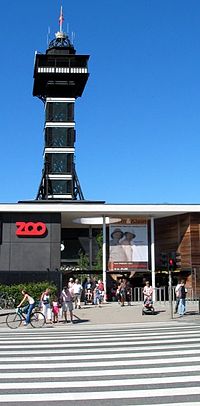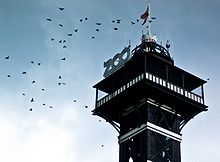- Copenhagen Zoo
-
Copenhagen Zoo 
Main entranceDate opened 1859 Location Copenhagen, Denmark Land area 11 hectares (27 acres) Coordinates 55°40′22″N 12°31′17″E / 55.67278°N 12.52139°ECoordinates: 55°40′22″N 12°31′17″E / 55.67278°N 12.52139°E Annual visitors 1,161,388 (2008) Memberships EAZA,[1] WAZA[2] Website http://www.zoo.dk/ Copenhagen Zoo (Danish: København Zoo) is a zoological garden in Copenhagen, Denmark. Founded in 1859, it is one of the oldest zoos in Europe. It comprises 11 hectares (27 acres) and is located in the municipality of Frederiksberg, sandwiched between the parks of Frederiksberg Park and Søndermarken. With 1,161,388 visitors in 2008 it is the most visited zoo and 4th most visited attraction in Denmark.[3] The zoo is noted for its new Elephant House designed by the world-famous British architect Sir Norman Foster. The zoo maintains and promotes a number of European breeding programmes and is active in the safeguarding several endangered species.
Contents
History
Copenhagen Zoo was founded by the ornithologist Niels Kjærbølling in 1859. He was given the summer garden of "Prinsess Vilhelmines Have" (The garden of Princess Vilhelmine) by the chief directorate of Copenhagen. The animals that the visitors could contemplate at the opening were eagles, chickens, ducks, owls, rabbits, a fox, a seal in a bathtub and a turtle in a bucket. In the early years the zoo focused on showing as many different types of animals as possible, but as animal welfare later became an issue, the number of different species has dropped in favour of more space to each animal.
One of the most notable animals kept there was a male slow worm that lived there from 1892 to 1946 (for 54 years, which is a record among lizards).[4][5]
Copenhagen Zoo today
During the last 25 years, Copenhagen Zoo has been undergoing a renovation project aimed at replacing cages with enclosures which recreate animals' natural environments, giving a better lifestyle to the animals, and a more realistic experience to visitors.[6] The Elephant House and 1.5-hectare (3.7-acre) Savanna are results of these efforts. The Savanna includes a Hippopotamus House where the hippos can be watched underwater.
The zoo has preserved many of its historical buildings. The oldest building still in use, a stable for yaks, was erected in 1872, and now houses the camels.[7] A Herbivore House built in 1875 still houses herbivores, namely tapirs. An owl tower from 1885 is today left as a memorial commemorating how zoo animals were once kept.[8] Another characteristic building is the Zoo Tower from 1905, an observation tower built entirely out of wood. 43.5 metres (143 ft) high, it offers views of the surrounding parklands and city.
Foster's Elephant House
The new Elephant House, opened in June 2008, is designed by Norman Foster in cooperation with the Danish landscape architect Stig L Andersson. It contains two glass-domed enclosures. One is for six cows and calves and measures 45 by 23 metres (148 by 75 ft). The other is 30 by 15 metres (98 by 49 ft) and is for two bulls, kept in separate pens during the mating season for fear of fights.[9] The building also contain an exhibit space and a small lecture hall. The enclosures open out through mighty rusted steel doors into am almost 1 hectare big landscaped paddock with a pool 3 metres (9.8 ft) deep and 60 metres (200 ft) long.[10]
The paddock's border with Frederiksberg Park, once a 3-metre (9.8 ft) high wall, has been opened up so that people in the park can now watch the elephants. This has been done because the zoo, with its central location is very much a city zoo, wants to integrate with the urban landscape. At the same time it affords the elephants distant views of open parkland and ancient trees.
Rare species
- Copenhagen Zoo is the only zoo outside of Australia that has Tasmanian Devils in captivity.[11]
- Copenhagen Zoo has the rare Amur Leopard
- Copenhagen Zoo has the rare Okapi
Exhibitions
Animals which are exhibited at the zoo but not in any of the main areas are for example bactrian camel, flamingo, ibis, spoonbill, pelican, vulture, snake, penguin, sea lion, squirrel monkey and lion.
Norden
In the part of the zoo called "Norden" (The north) visitors can see for example seal, reindeer, muskox, Eurasian eagle-owl, polar bear, brown bear and grey wolf.
Asien
In the are called "Asien" (Asia) visitors can see for example red panda, tapir, otter, leopard and tiger.
Sydamerika
In the area called "Sydamerika" (South America) viitors can see for example capybara, guanaco, nandu, mara, screamer and anteater.
Afrika
In the part of the zoo called "Afrika" (Africa) visitors can see for example rhinoceros, giraffe, impala, okapi, sable antelope, ostrich, zebra, hippopotamus, hornbill, Congo peafowl and caracal.
Øer
In the part of the zoo called "Øer" (Islands) visitors can see for example emu, kangaroo, Tasmanian devil, ring-tailed lemur and kea.
Børnezoo
In the area called "Børnezoo" (Children's zoo) visitors can see domestic animals like llama, goat, cow, pig, horse and chicken.
Animal Gallery
-
A Grey Crowned Crane (Balearica regulorumin)
-
Giant Anteater (Myrmecophaga tridactyla)
-
A young Banded Mongoose (Mungos mungo)
-
Grey Heron (Ardea cinerea) building a nest close to Frederiksberg Park
References
- ^ "EAZA Member Zoos & Aquariums". eaza.net. EAZA. http://www.eaza.net/membership/Pages/Zoos%20and%20Aquariums.aspx. Retrieved 27 May 2011.
- ^ "Zoos and Aquariums of the World". waza.org. WAZA. http://www.waza.org/en/site/zoos-aquariums. Retrieved 27 May 2011.
- ^ "Attraktionsstatistikken 2007 - top50". http://www.visitdenmark.com/NR/rdonlyres/6B0978E0-6822-4A88-9973-B2573288B329/0/VisitDenmarkAttraktionsstatistik2007_Top50.pdf. Retrieved 2009-04-11.
- ^ "Slow Worm". http://www.plantpress.com/wildlife/o105-slowworm.php.
- ^ "Slow Worm". http://www.fourmilab.ch/images/animal_magnetism/notasnake.html.
- ^ "Bygninger". Københavns Zoo. http://www.zoo.dk/BesogZoo/OmZoo/Bygninger.aspx. Retrieved 2009-01-23.
- ^ "Bygninger". Københavns Zoo. http://www.zoo.dk/BesogZoo/OmZoo/Bygninger.aspx. Retrieved 2009-04-11.
- ^ Glancey, Jonathan (2008-06-10). "Bygninger". London: Københavns Zoo. http://www.guardian.co.uk/artanddesign/2008/jun/10/architecture.animalwelfare. Retrieved 2009-04-11.
- ^ "Wait till you see our swimming pool!". The Guardian. http://www.zoo.dk/BesogZoo/OmZoo/Bygninger.aspx. Retrieved 2009-04-12.
- ^ Glancey, Jonathan (2008-06-10). "Wait till you see our swimming pool!". London: The Guardian. http://www.guardian.co.uk/artanddesign/2008/jun/10/architecture.animalwelfare. Retrieved 2009-04-12.
- ^ "Disease-plagued Tasmanian devils now endangered". Animal Planet. http://blogs.discovery.com/animal_news/2009/05/diseaseplagued-tasmanian-devils-now-endangered.html. Retrieved 2010-01-06.
External links
 Media related to Copenhagen Zoo at Wikimedia Commons
Media related to Copenhagen Zoo at Wikimedia CommonsZoos, aquariums, and aviaries Types of zoos Conservation Lists Animals Other topics - Animals in captivity
- Animal training
- Behavioral enrichment
- Captive breeding
- Frozen zoo
- Immersion exhibit
- Nocturnal house
- Wildlife conservation
- Zookeeper
- Zoology
- Portal
- Project
- Category
- Commons
Categories:- 1859 establishments in Denmark
- Zoos in Denmark
- Visitor attractions in Copenhagen
- Buildings and structures in Copenhagen
Wikimedia Foundation. 2010.







